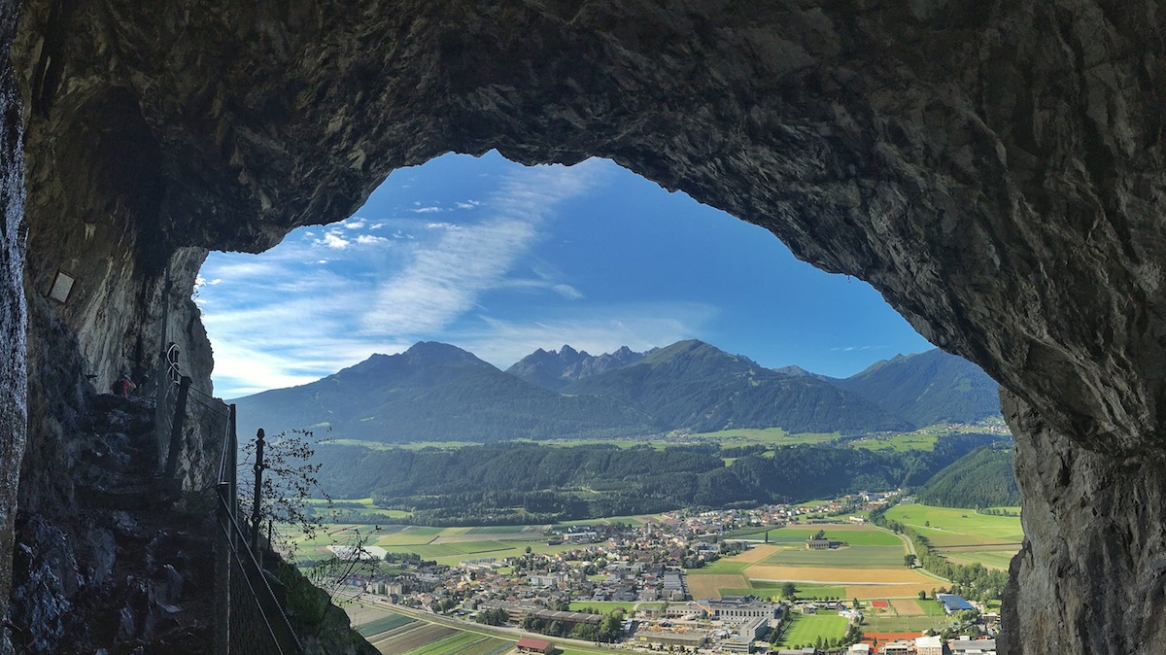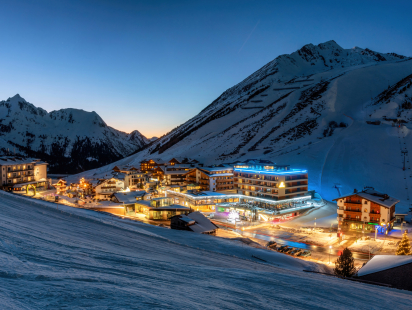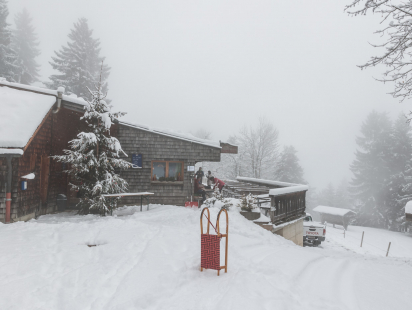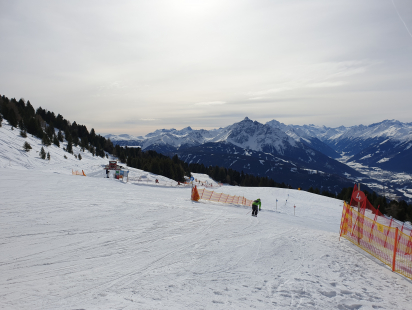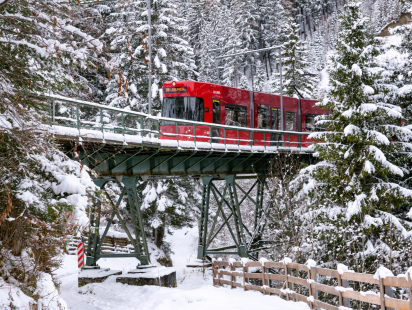“If only they kematen, if only they kematen!” In 1484, the cave in the Martinswand near Zirl sounds out desperately. The caller in the wall is none other than the still youthful later Emperor Maximilian. For three days and three nights he was stuck in the vertical rock face, not daring to go forward or back. He is shaken by anxiety attacks and hopes for rescuers to come. Perhaps he even regrets having followed the chamois and ibexes into this impassable and steep terrain in his desire to hunt. And that, to make matters worse, his misadventure was witnessed by the public. The first live dramatic event of the Middle Ages? I’m tempted to assume just that.

This is how the painter Ferdinand Graf zu Harrach saw the emperor: shivering and praying in the Martinswand.

Where today the footbridge runs just before the Max Grotto in the Martinswand, Emperor Maximilian might have crouched. ©Werner Kräutler
Heaven comes to the rescue

The legendary rescue of the Emperor from the Martinswand.
In this almost hopeless situation, Maximilian asks to be shown Holy Communion, at least from a distance, as was done for the hopelessly lost in those days. Suddenly a young man in peasant’s clothes appears and shows him the safe way out of the wall. “Be of good cheer, gracious sir!” begins the lad to speak-“God still lives, who can and will save you. Only follow me, and fear not!” The peasant boy leads the Emperor safely into the valley, Maximilian is saved. The fact that the saviour then disappears into the cheering crowd is just what the Habsburg needs. For soon it is said that the emperor has been saved by an angel of the Lord.
Every child in Tyrol knows this legendary incident. Just like the erroneous assumption that the place name Kematen goes back to the Emperor’s plea, “if only they would kematen…”. In reality, the name of the village comes from the word “Kemenate”. This was the name given to a heated chamber in the Middle Ages.
However, to this day there is only speculation as to how this incident took place in detail. However, it is highly probable that the emperor suffered some misfortune in the Martinswand. His salvation by an angel is then knitted exactly from that material, which makes a legend out of an accident.
Maximilian knitting his own Martin wall – legend
There are indications that Maximilian himself soon began to knit this, his own legend. For he who is saved by angels – so Majesty may have calculated – is a favorite of the gods for the common people. And so he had the event – the ‘accident’ in the Martin Wall – reported in the verse epic ‘Theurdank‘. For better explanation even including a graphic representation. (See illustration below). Theurdank’ is actually a biography, an account of Maximilian’s bridal journey to Mary of Burgundy and contains adventures and dangers that the bold knight Theurdank vulgo Maximilian experienced and had to endure. This also includes the almost fatal hunt in the steep face near Zirl. The angel saga, on the other hand, probably did not come directly from Maximilian’s hand. However, the tale that emerged among the people, together with the reasons for the miraculous rescue, must have been anything but inconvenient for him.
The show hunts at Martinsbühel
The Martinsbühel plays a decisive role in this legend. Situated directly at the foot of the Martinswand, this elevation was already a strategic point of special importance in the Latène period. The Romans built the Teriolis fort here as a supply depot for the garrison troops on the Danube-Iller-Rhine-Limes, the new borderline of the empire

Woodcut from the verse epic ‘Theurdank’
In the Middle Ages, the fortified complex “Sant Marteinsberg bei Zierlen” was built on the remains of the fort. Duke Sigismund the Rich and Emperor Maximilian later expanded the castle into a hunting lodge. No wonder, since from this point one could always keep an eye on the ibexes and chamois in the Martinswand
And now we come to theheart ofthematter: this is where the hunting-obsessed emperor held the so-called show hunts. The hunts were held ‘in front of an audience’, so to speak, mainly for ibex and chamois. That such events belonged to the outstanding events for clergy and high nobility should be undisputed. The fact that this ‘incident’ of Maximilian in the Martinswand took place in front of onlookers may be assumed. Narratives report that word of the emperor’s almost hopeless situation had spread quickly among the people and that “everywhere people were pleading for the salvation of their beloved lord”. It must therefore have been the very first live report in the High Middle Ages. Not bad either, in my opinion.

The rock overhang makes the Maximiliangrotte in the Martinswand the ideal setting for a miraculous rescue. ©Werner Kräutler

The Martinsbühel with the Palas and the Martinskirche, built over what is perhaps the oldest church in Tyrol, dating from the 5th or 6th century. From here nobles and clerics pursued the hunt in the Martinswand. And the misfortune of the emperor. ©Werner Kräutler

View from the ‘Maximilian Grotto’ of the Western Central Uplands. The first cross was placed in the wall at Maximilian’s instigation as early as between 1503 and 1504. ©Werner Kräutler
Maximilian was, as we know today, a highly gifted self-promoter. In new German: he was a marketing genius. The Habsburg was one of the first rulers to recognise the importance of the printing press, which had been invented shortly before. And in order to strengthen his position and popularity, as well as the memory of him among the people, he relied on the printed word in combination with woodcuts as early as the beginning of the 16th century. His commissioned work “Theurdank”, which had been prepared long in advance, was intended to present him as a God-sent hero who defied all the adversities of this world. In addition, between 1503 and 1504 he had a commemorative cross erected in the grotto, flanked by figures of St. Mary and St. John.
So it’s no wonder that Emperor Maximilian is so popular among the Tyrolean people to this day.
My tips
- The path to the Maximiliangrotte is secured throughout, child safe and starts at the Red Cross car park in Zirl
- The duration of the ascent to the grotto: about 1 1/4 hours. Good footwear with treaded soles is required.
- You can find a detailed description of the route here.
- For climbing enthusiasts: The Martinswand is an Eldorado for climbers.
Rate this article
Show me the location on the map
A volunteer at the "Schule der Alm" alpine farming school, cultural pilgrim, Tyrol aficionado and Innsbruck fan.
Similar articles
Who has experienced them, these clear, cold winter nights in the high mountains? Maybe even under a…
The toboggan run from the Rumer Alm is one of my absolute favorite toboggan runs. At just…
When I came to Austria at the age of 16, winter sports were still pretty exotic for…
Snow-covered forests, exercise in the fresh air, enjoying the winter... I am regularly drawn to go outside,…

